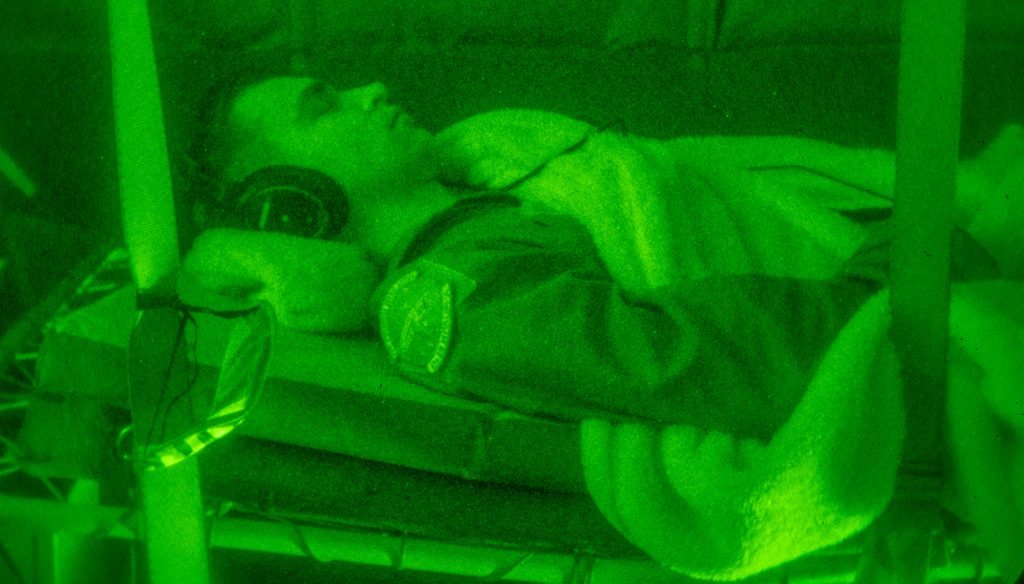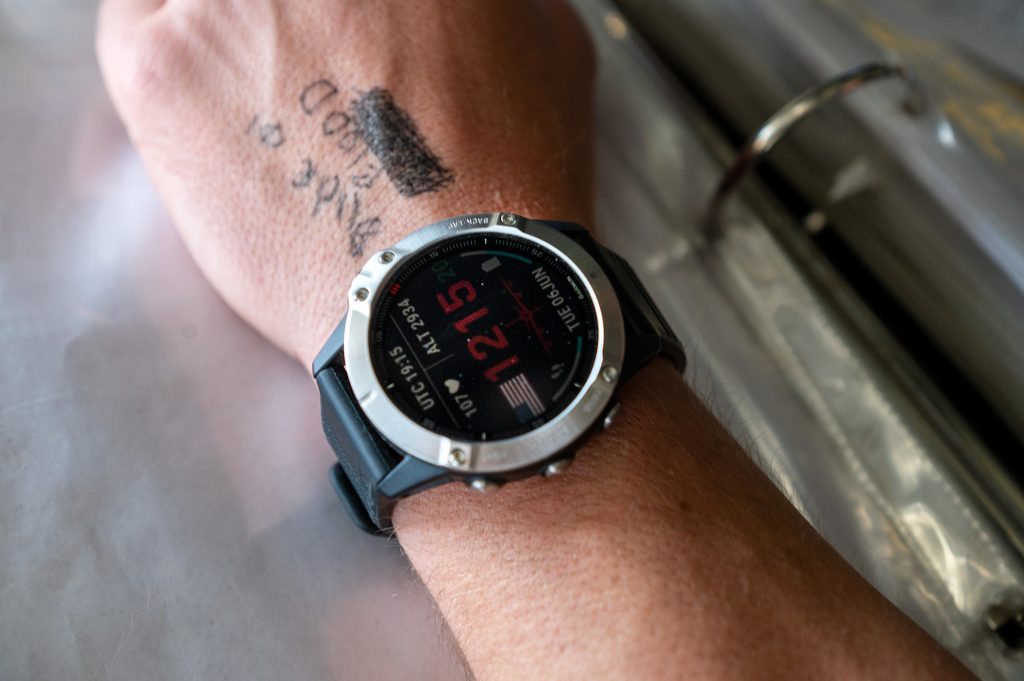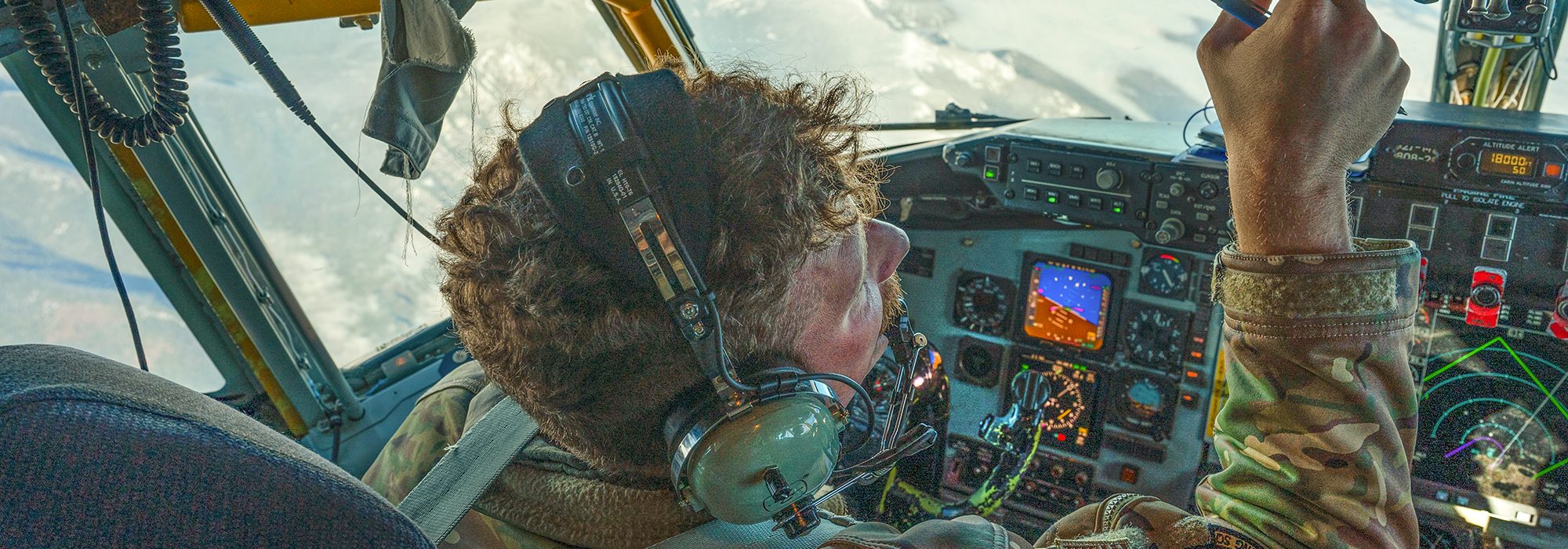In a vast region, with long flights, better human performance can be the difference between success and failure.
Maj. Nate Mocalis was dog-tired. He and five other Airmen were a little over halfway through a 72-hour mission flying a KC-135 tanker back and forth across the country, refueling other aircraft. Mocalis and his copilot were landing the 130-foot-long bird amid a strong crosswind after a 16-hour stint in the cockpit. They were stable all the way through the final approach and into the flare—the moment where pilots point the nose up slightly to bleed speed before touchdown—when the copilot let out the crosswind controls, forcing the pilots to accelerate and lift back into the air to avoid a serious mishap.
“That’s not something that this individual, with their high level of experience, would do on a normal day,” Mocalis recalled. “This was simply a fatigue-induced error.”
Fatigue is a common safety hazard. About 24 percent of Air Force Class A mishaps from 2003 to 2020 were fatigue-related, according to a study by Air Force scientists that was published in the May 2020 edition of the medical journal Aerospace Medicine and Human Performance. Mastering that challenge looms large as the Air Force eyes flying the vast distances that define the Indo-Pacific theater.
To prepare, the Air Force’s Air Mobility Command (AMC) hosted its first-ever Human Performance Industry Day conference in December at Scott Air Force Base, Ill., where Airmen and health tech companies shared the challenges and possible solutions for managing the mental and physical stresses of nonstop flying.
Pilot, Maj. Nate Mocalis, 92nd ARWThe status quo is we just ask the crew, ‘Hey, how’s everyone feeling.’. … But as humans we are really poor judges of objectively assessing our actual fatigue and risk.
“To be clear, this is about the Pacific challenge,” AMC Commander Gen. Mike Minihan told conference attendees. “We’re going to max-perform humans, and I want all the insights and assistance possible. Nothing’s off the table.”
Minihan envisions air and ground crews training to perform their jobs with minimal rest for 48 hours straight. He wants enablers that his troops can use now, whatever the cost.
“This is a ‘now, get it done’ thing for me,” Minihan said. “It’s not for us, it’s for the joint team. This is to make everybody else successful.”
Status Quo
The standard flight duty period for a single crew operating an Air Force aircraft is 16 hours, which includes two to three hours for travel to the operating location, briefing, and completing all the prerequisites before take off. The limit can extend to 24 hours or longer with extra crew members and a place to rest on the plane, or it can drop to 12 hours in cases of high-risk, high-stress missions, such as low-flying a C-130 through a combat zone.
The limits exist for a reason: Flying is hard and takes enormous concentration. Pilots must make thousands of decisions to keep their aircraft aloft, manage the crew, and complete their mission. The mental load is draining, said Maj. Melinda Marlow, a C-130 pilot, but the physical demands—ranging from extreme temperatures to noisy engines—also take a toll.

“What that all equates to is a significant cognitive load over a significant period of time, without the ability to do the things you might normally do to help relieve that,” the way office workers might go to the gym or take a walk, said Marlow, chief of staff action officer at AMC headquarters.
Easing that load—or knowing when a break might be most valuable—is hard to pin down, largely because aircrews lack the diagnostics to assess their own levels of fatigue.
“The status quo is we just ask the crew, ‘Hey, how’s everyone feeling?’” Mocalis said. “But as humans, we’re really poor judges of objectively assessing our actual fatigue and risk due to our levels of alertness.”
The more fatigued one is, the harder it is to know just how tired you really are, and how much that affects response times and judgment, experts say.
“If you get just five hours a night for weeks and weeks, you will start to think that’s normal, like ‘This is how I feel, this is how I operate,’” said Maj. James Brown, chief of the support flyer training branch at AMC’s operations directorate.
While smart watches, heart rate monitors and the like aren’t essential to know when one feels tired, those sensors can gauge how tired one is and when. For example, a psychomotor vigilance test (PVT) can track alertness by measuring how long—in microseconds—it takes a participant to tap a screen when cued. The PVT can establish a baseline that can then be used to demonstrate when someone is under-rested.
Combined with other sensors, that data can help monitor performance and make well-informed mission decisions. It should also help Airmen build the habits necessary to minimize fatigue, predict when individuals will be most exhausted, and assign missions to those best suited based on data, not just gut judgment.
“That’s a conversation starter for us to develop a game plan, like, ‘Hey this guy is more of a night owl compared to this guy who is a morning person,’” Mocalis said. “It helps us be smart in how we delegate missions.”
Enter Sandman
Despite all the energy drinks on the market, “there really is no chemical substitution for sleep,” said Col. Robert McCoy, AMC’s chief of aerospace medicine. Once it’s tired enough, the human body starts nodding off to grab microbursts of sleep, which can be dangerous for anyone operating a refueling boom, an aircraft, or any other vehicle.
While it may be impossible to get eight hours of uninterrupted sleep in the midst of a conflict, cat naps can do wonders for aircrew just trying to get through the next critical phase of flight. McCoy found that out for himself aboard a maximum endurance C-130 flight from Arkansas to the Philippines.
“A couple of the aircrew members had never taken a 15-, 20-minute nap, and they were amazed at how powerful a tool that could be,” he said. “That’s how most of us [physicians] got through medical school, those 15-, 20-minute naps.”
While any sleep is better than no sleep, humans sleep better in places that are cool, dark, and quiet. Military aircraft are none of those things. The noise level in a KC-135 is around 90 decibels, Mocalis said—about the same noise level as a gas-powered lawnmower. The floor of that aircraft is cold, while the ceiling can be unbearably hot. Cabin pressure is typically higher and the air drier than on commercial airliners, further straining crews and accelerating dehydration.
One solution could be providing sleep pods—small compartments on a single palletized container that could enable Airmen to get a better, high-quality, restorative sleep.
Sleep pods are one promising technology, but the main emphasis of AMC’s human performance effort is on helping Airmen better adapt to tiring circumstances.
“There is no real guidebook for aircrews on how to adjust their body clock and their circadian rhythm to perform on a different shift,” said Mocalis. “Each individual is trying to navigate that on their own without guidance.”
Warning Light
The 711th Human Performance Wing, the Defense Innovation Unit, AMC, and other groups are all working with off-the-shelf wearables and apps that can measure biometrics, including sleep quality, heart rate, stress, fatigue, and alertness. These tools could alert crew members before fatigue reaches dangerous levels.
“Inside your vehicle or your airplane, you have all these sensors that tell you how the airplane is doing or how the car is doing, but nothing on how you are doing,” said Brown. “It’s a mental check of, ‘OK, I should probably take a strategic nap or use some caffeine or get something to drink.’”
One effort at the 92nd Air Refueling Wing at Fairchild Air Force Base, Wash., is called Smart/Wearable Fatigue Tracking (SWiFT) and seeks to leverage wearables to track how Airmen’s fatigue levels change throughout the day and optimize their sleep and exercise patterns accordingly.

“Our crews can use this tool real-time in the cockpit to determine which pilot is best suited to fly a critical phase of flight, like taking the final landing after an exhausting multiday mission with multiple circadian rhythm swaps,” said Mocalis.
The major hopes these tools can help Airmen advocate for themselves, since they can now point to data showing they are objectively too tired to safely perform a mission. The data could also track the impact of other factors, like when McCoy enjoyed a hot meal aboard his max endurance flight to the Philippines.
“It was amazing how much a cooked meal rather than peanut butter and jelly, which is my go-to, makes a difference as a morale booster and how much more alert I was after eating that,” said McCoy.
The benefits may appear small at first: an hour of high-quality sleep here, a perfectly timed shot of caffeine there. In aggregate, those small edges could make all the difference in a future fight.
“We’re talking about extremes. The scenario in which we need to utilize maximum endurance operations is an extreme,” said Marlow. “So when we’re operating in these extreme environments, how do we do it safely and smartly?”
At AMC, Minihan wants to move fast on maximizing human performance, but knows aircrews must trust the technology they will be reliant on. Building trust requires delivering results, and Mocalis saw one promising result at the tail end of his 72-hour mission.
A day after the go-around incident, the pilot and his crew were exhausted after multiple circadian rhythm shifts and countless miles.
“It felt very much like the end of a massive road trip, as if battling through a snowy interchange at night in a foreign city,” he recalled.
Mocalis looked forward to letting his copilot handle the final landing of the mission, but first they decided to take a PVT. The test found that the copilot’s alertness was well below that of Mocalis’. He chose then to take the landing and put the plane down safely himself. For the first time, they had objective data to help them make the safest possible decision.
“When you feel tired, it’s a relief knowing it’s the other person’s turn to fly. But when you realize you’re the one who is the most alert,” the major said, “then it’s like ‘time to suck it up, let’s go!’”
